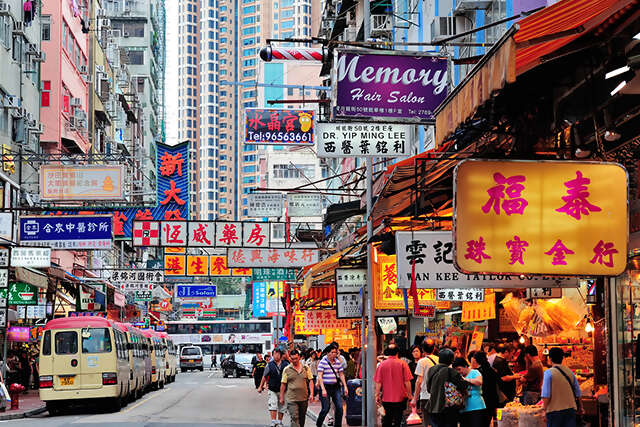Discover the people and places that shaped Hong Kong.
Taoist temples and Edwardian edifices nestle between skyscrapers, people trade on international markets and light incense to bodhisattvas, vestiges of Chinese clan heritage and European colonial history sit side by side — discover the people and places that shaped Hong Kong.
Chinese Temples
Hidden in lush hills and wedged between shining skyscrapers, Hong Kong’s temples are active places of worship and the focal point of the city’s festivals. Visit them to see faithful devotees of Buddhist, Taoist and local deities performing ancient rituals amid aromatic wafts of incense.
 |
Lo Pan Temple Located in Kennedy Town on the western end of Hong Kong Island, the Lo Pan Temple is the only temple in Hong Kong dedicated to Lo Pan, patron saint of Chinese builders and carpenters. Lo Pan was a Chinese carpenter, engineer, philosopher, inventor, military thinker and statesman who lived during the Spring and Autumn Period (771-476 BC). |
 |
Man Mo Temple The Man Mo Temple is a picturesque tribute to the God of Literature (Man) and the God of War (Mo), both of whom were worshipped by ambitious students looking to succeed in the civil examinations of Imperial China. These involved rigorous systems aimed at finding the best administrative officials for the state. |
 |
Shing Wong Temple |
 |
Chi Lin Nunnery and Nan Lian Garden Established in 1934 and renovated in Tang dynasty style (AD 618–907) in 1990, the Chi Lin Nunnery is a large temple complex of elegant wooden architecture, treasured Buddhist relics and soul-soothing lotus ponds. The complex also includes a series of temple halls, some of which contain gold, clay and wooden statues representing divinities such as the Sakyamuni Buddha and bodhisattvas. |
Historical Sites
Eastern Han dynasty (25 – 220) tombs, splendid 13th century ancestral halls, walled villages, elegant Victorian architecture and WWII relics tell the story of Hong Kong’s journey from a far flung outpost of Imperial China to the culturally diverse crossroads of a shrinking world.
 |
1881 Heritage A visit to 1881 Heritage will transport you to Victorian-era Hong Kong. From the 1880s to 1996, this was the headquarters of the Hong Kong Marine Police. Several buildings and artefacts of historical interest have been preserved and restored, and the site now features a shopping mall, a heritage hotel, and an exhibition hall. |
 |
Kowloon Walled City Park Kowloon Walled City Park sits on the very site of the former Kowloon Walled City, remembered today as a haven of crime and debauchery. |
 |
Cheung Po Tsai Cave Often portrayed as a latter-day Robin Hood, Cheung Po Tsai is a star subject of many stories and movies. The historical character was a notorious pirate in the South China Seas during the late 18th century, and is said to have once commanded a fleet of 600 ships and 50,000 men. The experience probably stood him well after he surrendered to the Qing Government in 1810 and was given an officer position in the Chinese Navy. |
 |
Lung Yeuk Tau Heritage Trail The Lung Yeuk Tau (‘Mountain of the Leaping Dragon’) Heritage Trail takes visitors on a scenic journey into the history of the Tang clan, one of the five largest clans in the New Territories. It is said that a dragon could once be seen leaping in the mountains here, which is how the area got its name. |
Living Culture
Constantly looking to the future while always honouring its past, Hong Kong breathes under the duality of a modern city enhanced by the richness of an ancient society. Visitors to Asia’s world city are invited to experience age-old rituals and time-tested wisdom of the East.
 |
Chinese Tea Reputedly discovered by Emperor Shennong in 2737 BC, tea has been synonymous with Chinese culture for thousands of years. Shiploads of it passed through Hong Kong on its way to Europe, where it would go on to become Britain’s national drink. Tea is usually served with meals in Chinese restaurants and, for many visitors, the most memorable flavour of Hong Kong will be flower or green tea. |
 |
Chinese Opera When it comes to evoking the mystery and charm of ancient China, few art forms can compare to Chinese opera, with its kaleidoscopic costumes, distinctive falsetto singing punctuated by gongs, and intricate gestures rich with symbolism. Despite serious competition from more modern forms of entertainment, traditional Chinese performance art in the form of Cantonese opera continues to persevere in Hong Kong as a beautiful and timeless craft. |
 |
Feng Shui Literally meaning ’wind and water’, feng shui is the ancient Chinese practice of positioning objects and buildings in harmony with nature to bring about good fortune. Often referred to as ‘geomancy’, its origins stem from an ancient Chinese respect for the environment, as well as a belief that cosmological influences have a strong effect on our lives. |





